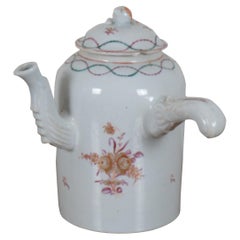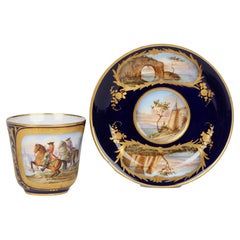Antique Porcelain Coffee Pots Cost
Late 18th Century Chinese Export Antique Porcelain Coffee Pots Cost
Porcelain
People Also Browsed
Late 19th Century French Late Victorian Antique Porcelain Coffee Pots Cost
Porcelain
18th Century and Earlier English Antique Porcelain Coffee Pots Cost
Porcelain
Mid-18th Century Chinese Chinese Export Antique Porcelain Coffee Pots Cost
Porcelain
Late 19th Century French Belle Époque Antique Porcelain Coffee Pots Cost
Porcelain
Late 19th Century Chinese Chinese Export Antique Porcelain Coffee Pots Cost
Porcelain
Late 18th Century Chinese Chinese Export Antique Porcelain Coffee Pots Cost
Porcelain
1730s German Georgian Antique Porcelain Coffee Pots Cost
Porcelain
Early 19th Century Chinese Chinese Export Antique Porcelain Coffee Pots Cost
Porcelain
Early 1700s Chinese Chinese Export Antique Porcelain Coffee Pots Cost
Porcelain
1790s Chinese Qing Antique Porcelain Coffee Pots Cost
Lacquer
Early 18th Century Chinese Qing Antique Porcelain Coffee Pots Cost
Porcelain
1790s Chinese Chinese Export Antique Porcelain Coffee Pots Cost
Enamel
1750s Antique Porcelain Coffee Pots Cost
Porcelain
Mid-18th Century English Chinoiserie Antique Porcelain Coffee Pots Cost
Porcelain
19th Century Chinese Qing Antique Porcelain Coffee Pots Cost
Jade
Early 20th Century Chinese Qing Antique Porcelain Coffee Pots Cost
Porcelain
A Close Look at chinese-export Furniture
Expanded trade between Europe and East Asia, starting in the 16th century, led to a booming market for exported goods, particularly furniture. This was bolstered by the establishment of the Dutch and English East India Companies at the beginning of the 17th century. From folding screens and chairs to lacquer tables and silver, Chinese Export furniture was in demand and regularly copied and imitated, leading to styles like chinoiserie and Chinese Chippendale.
The expansion of exporting that had strengthened the arts during the Ming dynasty continued into the Qing dynasty era — Chinese designers made many furniture pieces specifically for export, resulting in distinctive designs that mixed traditional techniques with forms appealing to foreign buyers. For instance, cabinetmakers in Canton (modern-day Guangzhou) were prolific in crafting hardwood furniture for export in European styles that involved the expert joinery techniques of Chinese furniture. Designs for Chinese Export porcelain, cabinets, decorative objects and other furniture were often more ornately adorned than they would be for a local audience, such as with mother-of-pearl overlays or surfaces featuring lavish pictorial scenes or gold on black motifs. Some were even commissioned by wealthy European families to be adorned with their coat of arms.
Because lacquer furniture was especially prized, and the resin used to create it was difficult to import as it would harden during the long voyage, artisans in China and Japan exported numerous lacquer pieces. Long before lacquer made its way to Japan, the Chinese treated the material differently. They used it to create smooth, glossy surfaces, but also for carving, an art that began in the 12th century and is exclusively Chinese. These pieces are called cinnabar lacquer after the powdered mercury sulfide (cinnabar) employed to produce their characteristic red hue. A popular form for export was a compact cabinet with drawers, usually displayed on a small table. Undecorated furniture built in Europe was also shipped to China to be lacquered. The international exchange of design would influence furniture into the 19th century and later, informing styles such as Art Deco and Art Nouveau.
Find a collection of antique Chinese Export tables, beds, cupboards, table lamps and more furniture on 1stDibs.
Finding the Right porcelain for You
Today you’re likely to bring out your antique and vintage porcelain in order to dress up your dining table for a special meal.
Porcelain, a durable and nonporous kind of pottery made from clay and stone, was first made in China and spread across the world owing to the trade routes to the Far East established by Dutch and Portuguese merchants. Given its origin, English speakers called porcelain “fine china,” an expression you still might hear today. "Fine" indeed — for over a thousand years, it has been a highly sought-after material.
Meissen Porcelain, one of the first factories to create real porcelain outside Asia, popularized figurine centerpieces during the 18th century in Germany, while works by Capodimonte, a porcelain factory in Italy, are synonymous with flowers and notoriously hard to come by. Modern porcelain houses such as Maison Fragile of Limoges, France — long a hub of private porcelain manufacturing — keep the city’s long tradition alive while collaborating with venturesome contemporary artists such as illustrator Jean-Michel Tixier.
Porcelain is not totally clumsy-guest-proof, but it is surprisingly durable and easy to clean. Its low permeability and hardness have rendered porcelain wares a staple in kitchens and dining rooms as well as a common material for bathroom sinks and dental veneers. While it is tempting to store your porcelain behind closed glass cabinet doors and reserve it only for display, your porcelain dinner plates and serving platters can safely weather the “dangers” of the dining room and be used during meals.
Add different textures and colors to your table with dinner plates and pitchers of ceramic and silver or a porcelain lidded tureen, a serving dish with side handles that is often used for soups. Although porcelain and ceramic are both made in a kiln, porcelain is made with more refined clay and is stronger than ceramic because it is denser.
On 1stDibs, browse an expansive collection of antique and vintage porcelain made in a variety of styles, including Regency, Scandinavian modern and other examples produced during the mid-century era, plus Rococo, which found its inspiration in nature and saw potters crafting animal figurines and integrating organic motifs such as floral patterns in their work.


